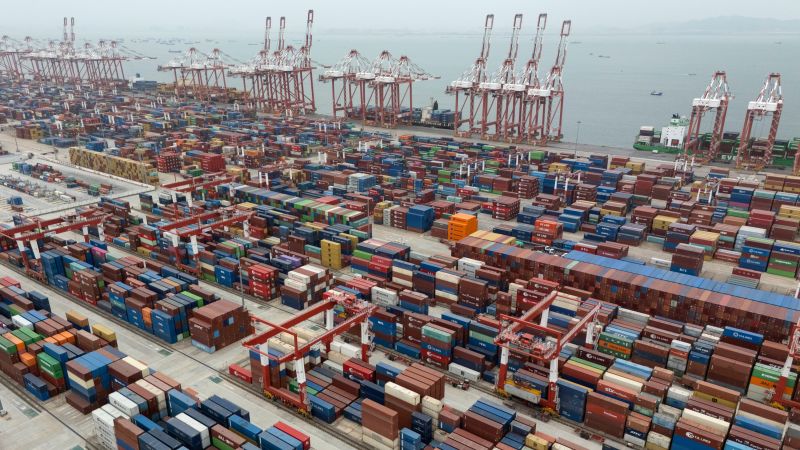Persistent Tariffs: How Trump's Trade War Affects Chinese Imports

Welcome to your ultimate source for breaking news, trending updates, and in-depth stories from around the world. Whether it's politics, technology, entertainment, sports, or lifestyle, we bring you real-time updates that keep you informed and ahead of the curve.
Our team works tirelessly to ensure you never miss a moment. From the latest developments in global events to the most talked-about topics on social media, our news platform is designed to deliver accurate and timely information, all in one place.
Stay in the know and join thousands of readers who trust us for reliable, up-to-date content. Explore our expertly curated articles and dive deeper into the stories that matter to you. Visit Best Website now and be part of the conversation. Don't miss out on the headlines that shape our world!
Table of Contents
Persistent Tariffs: How Trump's Trade War Continues to Shape Chinese Imports
The echoes of the Trump administration's trade war with China continue to reverberate through global markets. While the headline-grabbing tariffs may have subsided under the Biden administration, their lingering impact on Chinese imports remains significant, influencing everything from consumer prices to strategic industries. This article delves into the lasting effects of these tariffs and their complex implications for the US economy.
The Legacy of Section 301 Tariffs
The cornerstone of the Trump administration's trade strategy was the imposition of Section 301 tariffs on hundreds of billions of dollars worth of Chinese goods. These tariffs, ostensibly aimed at addressing intellectual property theft and forced technology transfer, targeted a wide range of products, from consumer electronics and apparel to industrial components and machinery. While some tariffs have been reduced or removed, many remain in place, creating a persistent drag on bilateral trade.
Beyond the Headlines: Long-Term Economic Impacts
The immediate impact of the tariffs was a surge in prices for affected goods. Consumers faced higher costs for everyday items, while businesses struggled with increased input costs. However, the long-term consequences are more nuanced and far-reaching:
-
Supply Chain Disruptions: The tariffs incentivized businesses to diversify their supply chains, moving production away from China to countries like Vietnam, Mexico, and India. This shift, while potentially beneficial in terms of diversification, also created new challenges, including increased transportation costs and logistical complexities. Learn more about the impact on global supply chains .
-
Inflationary Pressures: The increased cost of imported goods contributed to broader inflationary pressures in the US economy. This inflationary environment has presented significant challenges for the Federal Reserve in its efforts to manage monetary policy.
-
Retaliatory Tariffs: China responded to the US tariffs with its own retaliatory measures, impacting American agricultural exports and other goods. This tit-for-tat escalation further exacerbated the negative consequences of the trade war.
-
Impact on Specific Sectors: Certain sectors, particularly those reliant on Chinese-made components or finished goods, experienced disproportionately negative effects. The manufacturing sector, for example, faced increased costs and reduced competitiveness.
The Biden Administration's Approach:
While President Biden has not entirely reversed the Trump-era tariffs, his administration has adopted a more nuanced approach. The focus has shifted towards addressing specific concerns through targeted negotiations rather than broad-based tariff impositions. This more targeted approach aims to mitigate some of the negative economic consequences of the previous trade war while still addressing concerns about unfair trade practices.
Looking Ahead:
The long-term effects of the Trump-era tariffs on Chinese imports are still unfolding. While some businesses have successfully adapted to the new landscape, others continue to grapple with the consequences. The future of US-China trade relations remains uncertain, with ongoing tensions over technology, intellectual property, and human rights continuing to shape the economic relationship between the two superpowers. Understanding the lasting impacts of these tariffs is crucial for navigating the complexities of global trade in the years to come.
Call to Action: Stay informed about the evolving US-China trade relationship by subscribing to our newsletter for regular updates on global economic trends. [Link to Newsletter Signup]

Thank you for visiting our website, your trusted source for the latest updates and in-depth coverage on Persistent Tariffs: How Trump's Trade War Affects Chinese Imports. We're committed to keeping you informed with timely and accurate information to meet your curiosity and needs.
If you have any questions, suggestions, or feedback, we'd love to hear from you. Your insights are valuable to us and help us improve to serve you better. Feel free to reach out through our contact page.
Don't forget to bookmark our website and check back regularly for the latest headlines and trending topics. See you next time, and thank you for being part of our growing community!
Featured Posts
-
 Trending Baby Names 2024 A Look At The Years Most Popular Choices
May 15, 2025
Trending Baby Names 2024 A Look At The Years Most Popular Choices
May 15, 2025 -
 Subban Nhl Reaches Peak Popularity After Years Of Growth
May 15, 2025
Subban Nhl Reaches Peak Popularity After Years Of Growth
May 15, 2025 -
 Mlb Odds Pirates Vs Mets Matchup Preview And Predictions May 14 2025
May 15, 2025
Mlb Odds Pirates Vs Mets Matchup Preview And Predictions May 14 2025
May 15, 2025 -
 Three Giant Surprises Early 2025 Season Analysis Sf Giants
May 15, 2025
Three Giant Surprises Early 2025 Season Analysis Sf Giants
May 15, 2025 -
 Adelman The Coach Woody Paige Compares To Superman
May 15, 2025
Adelman The Coach Woody Paige Compares To Superman
May 15, 2025
Latest Posts
-
 Deodorant Recall Alert 67 000 Units Recalled Across Walmart Dollar Tree Amazon
Jul 17, 2025
Deodorant Recall Alert 67 000 Units Recalled Across Walmart Dollar Tree Amazon
Jul 17, 2025 -
 Life After Love Island Usa Amaya And Bryans Relationship Update
Jul 17, 2025
Life After Love Island Usa Amaya And Bryans Relationship Update
Jul 17, 2025 -
 September 2025 Ynw Melly Faces Retrial In Double Homicide Case
Jul 17, 2025
September 2025 Ynw Melly Faces Retrial In Double Homicide Case
Jul 17, 2025 -
 Love Island Usas Amaya And Bryan Building A Future Beyond The Villa
Jul 17, 2025
Love Island Usas Amaya And Bryan Building A Future Beyond The Villa
Jul 17, 2025 -
 September Retrial For Ynw Melly On Murder Charges After Jury Fails To Reach Verdict
Jul 17, 2025
September Retrial For Ynw Melly On Murder Charges After Jury Fails To Reach Verdict
Jul 17, 2025
